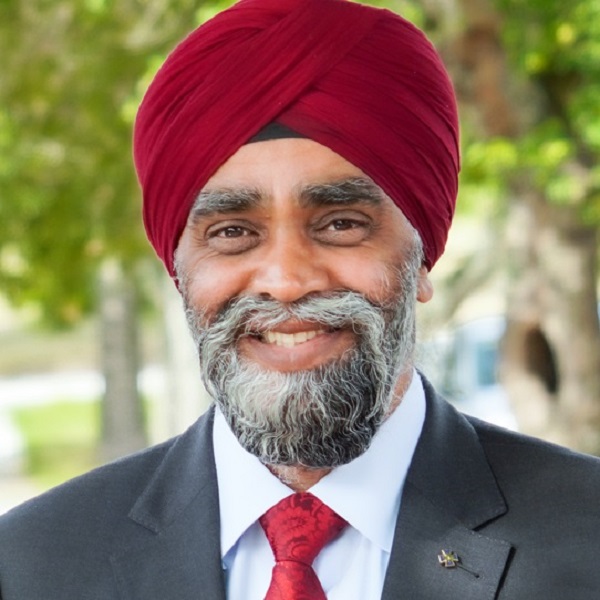“Minister Sajjan firmly rejects the allegations of impropriety published in the Globe and Mail”
THE World Sikh Organization of Canada (WSO) said on Thursday that it is deeply concerned by a front-page story published in the Globe and Mail entitled “Sajjan instructed special forces to rescue Afghan Sikhs during fall of Kabul.”
The article raises questions around the efforts to evacuate Afghan Sikhs during the fall of Kabul in August 2021. These evacuation efforts were driven by the dire humanitarian need to protect the highly vulnerable Afghan Sikh and Hindu communities. Allegations that then-defence minister Harjit Sajjan acted inappropriately are unfounded and appear to be influenced by bias against his Sikh identity.
The WSO pointed out that Afghan Sikhs and Hindus faced relentless persecution and brutal attacks in the years leading up to the Taliban’s takeover. These attacks included bombings, targeted killings, and systematic discrimination, putting the community at extreme risk. In July 2018, a suicide bomb attack killed 19 Sikh and Hindu leaders as they headed to meet President Ashraf Ghani. In March 2020, a suicide attack on the Guru Har Rai Sahib Gurdwara in Kabul killed 25 Sikhs. The Islamic State warned that it would continue to target and kill all Sikhs in Afghanistan. The community, which once numbered in the tens of thousands, was reduced to approximately 225 vulnerable individuals.
As the situation in Afghanistan deteriorated, the WSO, along with other organizations and political leaders, called upon the Canadian government to evacuate Afghan Sikhs and provide them with a safe haven. Canadian Sikhs had offered to privately sponsor the evacuated refugees.
In July 2020, a group of 25 Canadian MPs from the Conservative Party of Canada (CPC), New Democratic Party of Canada (NDP), and the Green Party wrote to then-immigration minister Marco Mendicino calling for a special program for Afghan Sikh and Hindu refugees so that they could be brought to safety in Canada.
In August 2021, the WSO, along with other groups, called repeatedly on the Canadian Government to evacuate the approximately 225 remaining Afghan Sikhs and Hindus to safety.
WSO President Danish Singh said: “Evacuating vulnerable groups like Afghan Sikhs and Hindus was a humanitarian duty that any Canadian minister should have undertaken. The suggestion that Minister Harjit Sajjan acted on this issue because he is a Sikh is deeply troubling and reflects a disturbing bias.
“The Globe and Mail story doesn’t mention the history of terror attacks and suicide bombings faced by Afghan Sikhs and Hindus. It also doesn’t mention the ongoing threats by Islamic State to wipe these communities out. There was no doubt that Sikhs, being a very visible minority, would continue to be the target of attacks. The attempts to evacuate Afghan Sikhs and Hindus were not about favouritism but about responding to an urgent humanitarian crisis.
“It’s deeply concerning that humanitarian efforts to rescue an undeniably vulnerable community are being scrutinized through a lens of bias. Our focus should be on Canada’s moral and international obligation to protect those at risk, regardless of their religious or ethnic background.
“The insinuation that Minister Sajjan prioritized Sikh interests over Canadian interests is not only baseless but also dangerously divisive. This narrative perpetuates a troubling and unfounded stereotype about Sikh Canadians having disproportionate influence in politics – a claim that has long been used to marginalize Sikh voices in public discourse.
“Ironically, while Sikh Canadians have advocated since 2015 that more should be done to save the lives of Afghan Sikhs and Hindus, it’s a failed last-minute evacuation attempt by Canadian forces that is now being mischaracterized as special treatment or undue privilege.
“We would agree with Minister Sajjan’s assessment – if he did not wear a turban, there would be no question as to whether his actions were appropriate.”
MEANWHILE, Emergency Preparedness Minister Sajjan’s office in an emailed statement on Thursday said:
“Minister Sajjan firmly rejects the allegations of impropriety published in the Globe and Mail, today.
“It was the government’s policy to not only help Canadians and people with ties to Canada, but also other vulnerable groups, including religious minorities like Afghan Sikhs and Hindus.
“This policy was clear, it was public and expressed here: https://www.canada.ca/en/immigration-refugees-citizenship/news/2021/08/canada-expands-resettlement-program-to-bring-more-afghans-to-safety.html
“Minister Sajjan provided a thorough and complete statement to the Globe yesterday, detailing the policy, the government’s work to implement it, and the facts surrounding the plight of these vulnerable Afghan Sikhs.”
The statement:
I am enormously proud of the work the Government of Canada undertook to try to help evacuate and bring to safety a group of Afghan Sikhs who in August 2021 were in dire circumstances and faced severe threat from the Taliban and others.
This amazing work, led by the government, and implemented by the brave women and men of the Canadian Armed Forces and dedicated public servants, was just one part of an extraordinary effort that protected and saved the lives of thousands of Afghans.
In coordination with international allies, our troops and officials were able to successfully evacuate more than 3700 people from Afghanistan including Canadian citizens and permanent residents, citizens of allied countries, Afghan nationals with links or who worked for Canada, and other vulnerable Afghans. I am thankful for their work.
Three weeks ago, the Globe and Mail asked me a specific question: “’Back in August 2021, when Kabul was falling, why did you ask the Canadian special forces to go and try to rescue about 200 Sikhs around a temple there?”
I did not order Canadian Special Operations Forces to mount a rescue mission at a Gurdwara in Kabul – or anywhere else in Kabul. The Afghan Sikhs were already in proximity of the Airport.
The Canadian Armed Forces was not directed to prioritize the evacuation of Afghan Sikhs over Canadians, Afghan interpreters, or others who aided Canada during the many years of our mission in Afghanistan.
That said, the Government of Canada worked very hard to help Afghan Sikhs under threat of violence and persecution to get out of Afghanistan and to bring them to Canada and other safe places. This was not work I undertook on my own. It was the policy of the Government of Canada and the work of ministers and officials across the government.
In July and August 2021, the Government of Canada expanded its ongoing efforts to help vulnerable minorities in Afghanistan targeted by the Taliban and others. These vulnerable groups included women leaders, human rights defenders, journalists, persecuted religious minorities (including Sikhs and Hindus), 2SLGBTQI+ individuals and more.
At the same time, the government announced the expansion of its existing partnership with the Alberta-based NGO the Manmeet Singh Bhullar Foundation to resettle hundreds of persecuted Afghan Sikhs and Hindus.
The NGO had been working to identify vulnerable Sikhs and Hindus in Afghanistan and to provide their names to Immigration, Refugees, and Citizenship Canada (IRCC) officials to facilitate their travel to Canada. As a result of their efforts, and during the weeks before the fall of Kabul, this NGO partner identified a group of more than 200 Sikhs who were under threat from the Taliban and others in Kabul. Officials at IRCC and other government departments worked with the NGO to facilitate the evacuation of these Afghan Sikhs from Kabul.
At the time, I was focused intently on the full breadth of evacuation operations and fulfilling my duties as Minister of National Defence. The government’s priority was to evacuate, first and foremost, Canadians, Afghan translators and those with significant links to Canada. This was our main effort. The evacuation and resettlement of other vulnerable populations, including Sikhs, was also a government priority.
I provided direction to the Canadian Armed Forces, through the appropriate chain of command, to assist the group of Afghan Sikhs who had been determined eligible for evacuation from Kabul through the process underway at IRCC. The operational details of how and where to do this work was left to military operational commanders and tactical decision-makers on the ground.
I did not direct the Canadian Armed Forces to prioritize Sikhs above others. We had a duty and an obligation to Canadians and those with strong ties to Canada, and we also had a responsibility to protect the vulnerable, as we tried to do, in the case of journalists, members of parliament, persecuted religious and other minorities, and others at specific risk.
Neither I nor my office provided documents or letters of facilitation to the Afghan Sikhs. Any such letters were provided by the appropriate officials at IRCC, as part of the efforts of the Government of Canada to facilitate the travel and evacuation of this group.
As the situation in Kabul became more chaotic and the need for evacuation became more dire, our NGO partner reached out to me personally to share information and concern about the plight of these Sikhs, who were having trouble linking up with Canadian Forces on the ground in Kabul. I relayed whatever information the NGO provided about the location and status of these Sikhs to the chain of command for it to use as it saw fit, in line with its operational plan on the ground in Afghanistan. I did not direct the CAF to undertake a rescue mission at a Gurdwara, or anywhere else. At all times, my message to the NGO was the same as the one CAF was delivering directly to the Afghan Sikhs through its own channels: Move toward the airport.
I will not get into operational details, but I can say, as the situation at the gates of the Hamid Karzai International Airport became more challenging, and the threat of violence and attack at those facilities increased, the Canadian Armed Forces identified a rendezvous point very near to the airport where it could gather different people and groups of people it was trying to assist and facilitate their transit through security lines defending access to the airport.
This was part of Canadian Armed Forces operational work, and the plan and location were determined by Canadian tactical commanders and soldiers on the ground. The plan was communicated directly to the Afghan Sikhs by Canadian Armed Forces members who had established direct contact.
This rendezvous tactic was made necessary by increasing crowds and threat levels at the airport entry gates, which culminated in a terrible suicide bombing at a gate on August 26th that killed nearly 200 Afghans and 13 US troops.
In the end, the government was unable to evacuate from Kabul this group of Afghan Sikhs although other efforts were more successful.
As Minister of National Defence my mission was to safely evacuate as many vulnerable Afghans as possible in accordance with the policy of the Government of Canada. I am extremely proud of the extraordinary work CAF members accomplished during a chaotic situation.
Many Afghans—especially interpreters—are alive today because of the heroic efforts of our soldiers. It does sadden me to be answering this question when it was clear Sikhs and other minorities were part of government policy to support and assist vulnerable Afghans. I can only surmise that if I did not wear a turban no one would question whether my actions were appropriate. They were entirely in accordance with policy set by our Government.











